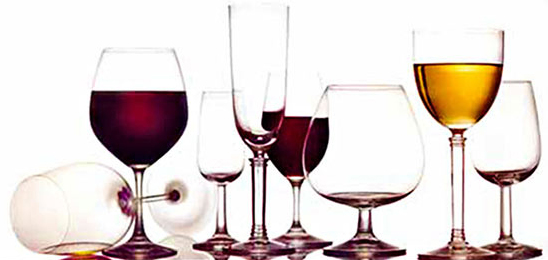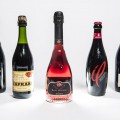It’s In The Glass . . . by Joel Mann, Staff Wine (And Beer) Tasting Guy

Beverage producers spend a great deal of thought and effort into making the best tasting drink possible. Brewers source just the right hops. Winemakers fuss over the proper ripeness in the vineyard. Distillers concern themselves with the proper moment to cut the heads and tails coming off the still. There’s aging, blending, packaging decisions, and even fussing about the proper temperature to store and serve everything. One of the least emphasized aspects of the final flavor, but one that has a noticeable impact, is the glass itself.
The size, shape, and general condition of the glassware used to serve your beverage can alter your perception of beverage flavor. Numerous companies have researched this effect, and developed a whole range of glassware specific to given beverages to enhance the character and final flavor that you as the consumer sense when drinking their product. This month I wanted to take a quick look at the properties of the final piece of the beverage chain, which is the very glass you drink from.
Serving vessels have evolved through a wide range of shapes and materials throughout history. From ancient pottery cups, to wooden mugs, medieval pewter chalices and goblets, to the lead glass crystal of wealth and royalty, the purpose was to simply hold the liquid in the glass for you to drink; or if you were wealthy to extravagantly hold the liquid in the glass for you to drink. As food science developed over the 20th century, and the role of sensory analysis in food offerings increased, and a number of producers began looking at the effects of the glassware on final flavor perception. The goal was to determine the ideal size, shape, and materials to best present the intended flavor of the beverage to you the consumer. A number of distinct serving glasses have been created as a result.
One of the better examples of change in this area is the Champagne flute. Champagnes and sparkling wines were traditionally served in wide, shallow, margarita type serving glasses. The problem with this style of glass is that it gives a large surface area to dissipate the carbon dioxide dissolved in the wine. This does two things: makes the wine go flat quicker, and also causes more CO2 in the sensory profile of the wine as more evolving gas is in the headspace above the liquid versus the wine aromatics. Enter science, and a tall, narrow glass was developed instead. The small headspace keeps more bubbles in the bubbly, and when filled to the proper height allows a higher concentration of wine aromatics in the headspace versus the CO2.
While there are distinct styles for specific wines such as Burgundy and Bordeaux, the common glass in the wine world has become the tulip bowl stemware, with a larger bottom bowl that tapers into a narrower opening at the mouth of the glass. For red wines, the glass is large with a deep bowl and ample headspace. For white wines, the glass is smaller with a shorter headspace area and typically a narrower mouth versus a wider bowl. The stem is to hold the glass and avoid heat transferring from your hand through the thin glass of the bowl and warming the wine.
The larger headspace in red wine glasses allows ample collection of volatile aromas when the wine is swirled, which concentrate in the tulip shape towards the narrow mouth. The smaller size, shorter headspace, and wider bowl to narrower opening for white glasses better suits aromatic concentration as the colder serving temperatures of white wines reduces aromatic volatility.
The beer side of the industry has a wide array of glassware as well. The best example is to look at the specialty glasses designed for all the various Belgian beers. Most Belgian beer companies over time have designed their own special serving glass to best emphasize the flavor profile of the beer. Duvel for instance uses its famous rosebud shaped glass. Stella has its wide tulip pitcher chalice. While Chimay prefers a more squat, open chalice shape. And serving the improper beer in the improper glass is considered a high offense when drinking in Belgium.
There are so many types of glassware, this article could continue for pages in the discussion of each. Just know that for maximum flavor, pouring your beverage into the proper glass matters. Consider the style of drink, what best accentuates its character, and how the shape of the glass best shows that off when making your choice.
Drink responsibly.





